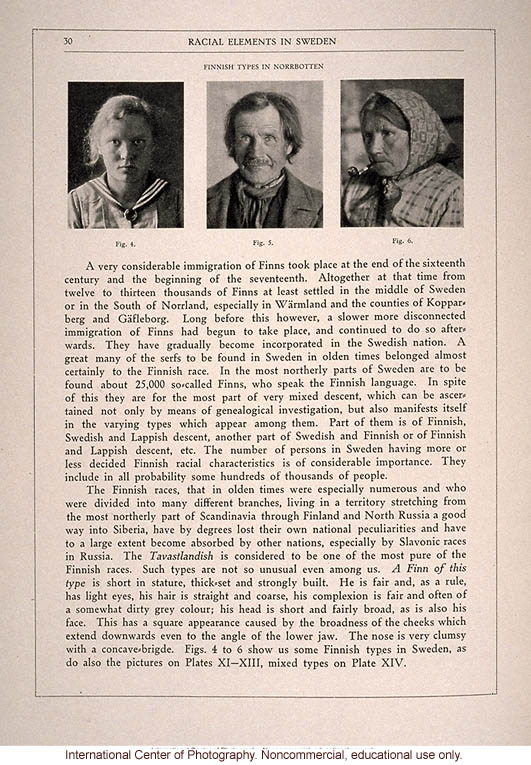[hairline boxed text]
30 Racial Elements in Sweden
[hairline score]
Finnish Types in Norrbotten
[three photos][photos' captions] Fig. 4.
Fig. 5.
Fig. 6.
A very considerable immigration of Finns took place at the end of the sixteenth century and at the beginning of the seventeenth. Altogether at that time from twelve to thirteen thousands of Finns settled in the middle of Sweden or in the South of Norrland, especially in Warmland and the counties of Kopparberg and Gafleborg. Long before this however, a slower more disconnected immigration of Finns had begun to take place, and continued to do so afterwards. They have gradually become incorporated in the Swedish nation. A great many of the serfs to be found in Sweden in olden times belonged almost certainly to the Finnish race. In the most northerly parts of Sweden are to be found about 25,000 so-called Finns, who speak the Finnish language. In spite of this they are for the most part of very mixed descent, which can be ascertained not only by means of genealogical investigation, but also manifests itself in the varying types which appear among them. Part of them is of Finnish, Swedish and Lappish descent, another part of Swedish and Finnish or of Finnish and Lappish descent, etc. The number of persons living in Sweden having more or less decided Finnish racial characteristics is of considerable importance. They include in all probability some hundreds of thousands of people.
The Finnish races, that in olden times were especially numerous and who were divided into many different branches, living in a territory stretching from the most northerly part of Scandinavia through Finland and North Russia a good way into Siberia, have by degrees lost their own national peculiarities and have to a large extent become absorbed by other nations, especially by Slavonic races in Russia. The [italics]Tavastlandish[end italics] is considered to be one of the most pure of the Finnish races. Such types are not so unusual even among us. [italics]A Finn of this type[end italics] is short in stature, thick-set and strongly built. He is fair and, as a rule, has light eyes, his hair is straight and coarse, his complexion is fair and often of a somewhat dirty grey colour; his head is short and fairly broad, as is also his face. This has a square appearance caused by the broadness of the cheeks which extend downwards even to the angle of the lower jaw. The nose is very clumsy with a concave brigde[sic]. Figs. 4 to 6 show us some Finnish types in Sweden, as do also the pictures on Plates XI-XIII, mixed types on Plate XIV.
[end]


